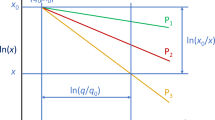Summary
Most existing models of blasting are stress-based and involve many fundamental parameters difficult or impossible to measure in practice. Even a single prediction with such models takes large quantities of computer time, so that calibration becomes a major impediment to their practical use.
The model in this paper is based on a simple kinematic approach to modelling muckpile formation. This has the advantage of relative simplicity, while still reflecting the essence of the blasting displacement process. Because of the simple implementation, the model can be calibrated against field data in a straightforward manner and then used for predictions at the same site. The inputs to the model are simply the blast design parameters. The output of the model is a muckpile cross-section, within which contours of diggability or distribution of materials can also be calculated. Case studies have shown that, provided the model is calibrated to the site condition, it will give accurate predictions for altered blast designs.
Similar content being viewed by others
References
Cherry, J.T. (1967) Computer calculations of explosion produced craters,International Journal of Rock Mechanics and Mining Sciences 4, 1–22.
Chiapetta, R.F. and Borg, D.G. (1983) Increasing productivity through field control and high-speed photography, inProceedings of the 1st International Symposium on Rock Fragmentation by Blasting, Lulea, Sweden, pp. 301–29.
Harries, G. (1987) The calculation of heave and muck-pile profile, inProceedings of the Second International Symposium on Rock Fragmentation by Blasting, Keystone, Colorado, 23–26 August, pp. 248–256.
Lemesh, N.I. and Pozdynakov, B.V. (1971) The kinematics of motion of ledge rock in the zone of fracture during blasting, translated fromFiziko-Tekhnicheskie Problemy Razrabotki Poleznykh Iskopaemykh 4, 36–40. orSchamaun, J.T. (1983). An engineering model for predicting rubble motion during blasting, inProceedings of the 9th Conference on Explosives and Blasting Techniques, Society of Explosive Engineers Annual Meeting, Dallas, Texas, pp. 199–222.
Yang, R.L., Kavetsky, A. and Lilly, P.A. (1986) A kinematic model for the prediction of fragment trajectories and muckpile shape during bench blasting, inProceedings of the AusIMM/IE, Large Open Pit Mining Conference, October, pp. 117–122.
Author information
Authors and Affiliations
Rights and permissions
About this article
Cite this article
Yang, R.L., Kavetsky, A. & McKenzie, C.K. A two-dimensional kinematic model for predicting muckpile shape in bench blasting. International Journal of Mining and Geological Engineering 7, 209–226 (1989). https://doi.org/10.1007/BF00880943
Received:
Issue Date:
DOI: https://doi.org/10.1007/BF00880943




